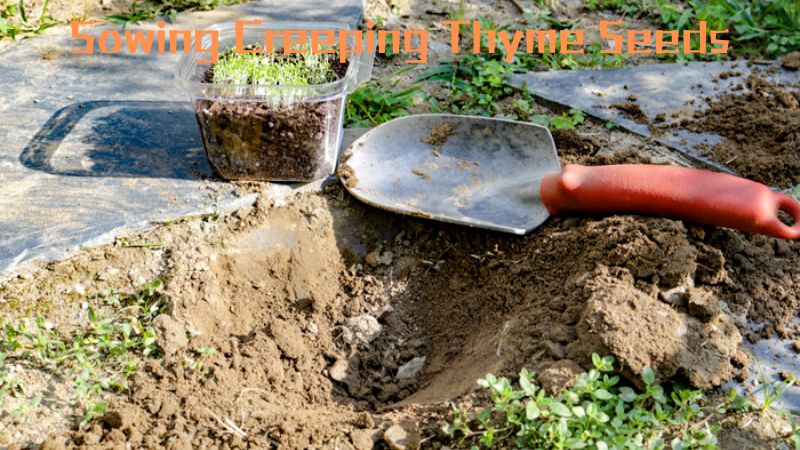Thyme is a popular herb in gardening and cuisine thanks to its unique flavor and diverse uses. Sowing creeping thyme seeds properly will help you get healthy thyme plants that provide great flavor for your dishes. In this article, Garden Creatives will guide you step by step through the process of sowing creeping thyme seeds to achieve the best results.
Origin and Characteristics of Thyme Plant
Origin
Thyme belongs to the Lamiaceae family and is native to the Mediterranean region. It has been grown and used since ancient times, with records of thyme’s use in medicine and cooking appearing in ancient civilizations such as the Greeks, Romans and Egyptians. The ancient Greeks considered thyme a symbol of courage and often used it in rituals to worship their gods.
Characteristics of Thyme Plant
Shape and Size:
Small Herb: Thyme is a low herb that grows in a bush form. The plant is 15 to 30 cm (6-12 inches) tall and can spread 30 to 45 cm (12-18 inches).
Stem: Thyme stems are woody at the base, with small, slender branches growing from the base.
Leaves
Shape and Size: Thyme leaves are small, usually oval or elliptical in shape, with a length of 5 to 15 mm (0.2-0.6 inches). The leaves are usually dark green and may be slightly hairy.
Texture: The leaves have a characteristic aroma and strong flavor, thanks to the essential oils in the cells.
Flower
Color and Characteristics: Thyme flowers are small, usually white, pink or purple. They grow in clusters at the ends of branches and bloom in the summer.
Shape: The flower is shaped like flowers of the mint family, with small petals arranged in clusters.
Roots
Root System: Thyme has a shallow, branched root system that helps it grow vigorously in poor, well-drained soils.
Flavor and Uses
Flavor: Thyme has a strong and slightly spicy flavor, with aromatic compounds such as thymol and carvacrol.
Uses: Thyme is widely used in cooking to flavor soups, stews, grilled meats and salads. In addition, thyme is also used in traditional medicine to treat digestive problems, coughs, and colds. Thyme essential oil is also used in beauty and health care products.
Thyme is an easy-to-grow herb and has many benefits, from culinary uses to medicinal and beauty care applications. Its combination of beauty, fragrance and uses has made thyme a popular choice in gardens and kitchens worldwide.
How sowing creeping thyme seeds properly
Soil and Site Preparation
Choosing a Location
Thyme needs lots of light to grow well, so choose a spot in your garden that gets full sunlight, at least 6 hours a day. Thyme can also grow well in pots or containers if you don’t have the garden space.
Soil Preparation
Thyme loves well-drained and slightly dry soil. If your soil is heavy or retains water for a long time, improve it by adding sand or compost to increase drainage. The soil should be loose and have a pH between 6.0 and 8.0.
Sow Seeds
Time to Sow Seeds
Thyme can be sown in spring after danger of frost has passed, or indoors before to allow the plants to establish before the outdoor growing season. The ideal time to sow seeds is when the soil temperature reaches about 18-21°C (65-70°F).
How to Sow Seeds
Sow Seeds Indoors: You can start seeds in pots or seeding trays indoors. Sprinkle the seeds evenly on the soil surface. There is no need to bury the seeds too deep because they need light to germinate.
Sowing Seeds Outdoors: If sowing seeds directly in the garden, spread the seeds evenly over the prepared soil surface and gently press the seeds into the soil for good contact.
Care After Sowing
Sprinklers
Keep the soil moist but not waterlogged. Thyme needs a moderate amount of water to grow. Water gently to avoid covering the seeds or eroding the soil. Make sure the soil dries slightly between waterings to prevent root rot.
Germination Conditions
Thyme seeds usually germinate in about 2-3 weeks. Make sure to keep the soil moderately moist and keep it at a constant temperature between 18-21°C (65-70°F) to aid germination.
Care and Maintenance
Prune
As your thyme plant begins to grow, you may need to prune it to keep it neat and encourage the growth of new branches. Regular pruning will help the tree grow denser and healthier.
Fertilizer
Thyme does not require much fertilizer. You can apply organic or light synthetic fertilizer in early spring to provide additional nutrients to the plant. Avoid over-fertilizing as this can reduce the flavor of the leaves.
Disease and Pest Control
Thyme is usually quite resistant to disease, but watch for signs of fungal disease or pests. If detected, treat early with natural or chemical methods depending on the severity.
Harvest and Use
Harvest
You can harvest thyme leaves when the plant has reached a height of about 15-20 cm (6-8 inches). Cut the leaves when the plant is still young to ensure the freshest flavor. For potted thyme plants, cut off a portion of the leaves without damaging the entire plant.
Use
Thyme can be used fresh or dried in many dishes. Its leaves have a strong flavor and are often added to soups, stews, grilled meats or as a seasoning for salads. Herbal tea can also be made from thyme leaves.
Conclude
Sowing creeping thyme seeds is a great way to add the versatile herb to your garden and improve the flavor of everyday dishes. By properly preparing the soil, sowing seeds at the right time, and meticulously caring for the plants, you will have a lush and aromatic garden. Try sowing thyme seeds and enjoy the benefits it brings to your living space.





